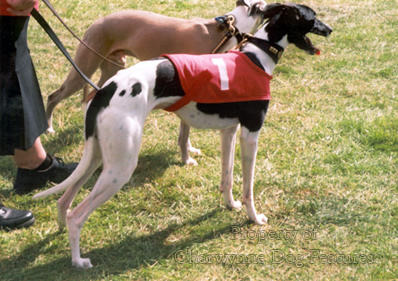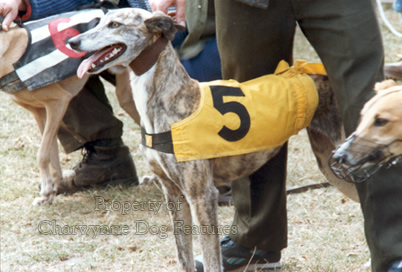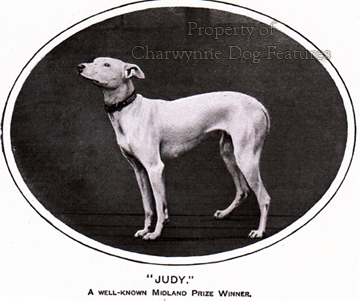889 THE WHIPPET - SNAP-DOG OR LURCHER
THE WHIPPET - SNAP-DOG OR LURCHER?
by David Hancock




A year ago, at a country fair I saw Whippets being raced as an event in the day's programme and was surprised at how big they were. Do they truly need this size to triumphthrough speed - or were the snap-dogs that inspired the creation of this breed just dwarf dogs fast enough to wager on? Snap-dogs were owned by hard-headed owners, anxious to win prize money but canny enough to reduce feeding costs. Why favour a bigger dog with a larger appetite when a smaller dog can win? Or were all the snap-dogs similarly small so that size wasn't a factor in successful racing?The show fanciers complain regularly about their breed getting too big to be the real thing, labelling the oversize ones 'lurchers'. And a large Whippet does hint at Greyhound blood. Today, according to the KC the 'desirable' height for the Whippet is 18 and a half inches to 20 inches; in 1938, the 'ideal' height was 18 and a half inches. In 1904, Herbert Compton, writing in his The Twentieth Century Dog, stated that: “The whippet affords a remarkable illustration of the talent, not to say genius, of the dog fancier, and his ability to manufacture new types of dogs. No one looking at the picture of Manorley May, (pictured) and bearing in mind her height, which is 17 inches, and her weight of 19lbs, could desire a more exquisitely proportioned four-legged creature, or one more instinct with the attributes of swiftness and virility made apparent…To all intents and purposes it represents a new species of dog…” But a big Whippet can look like a small Greyhound.

In his monumental Dogs: Their History and Development of 1927, Edward Ash refers to a Yorkshire strain of small Greyhound bred by a Mr Hodgson of Stamford Bridge in the East Riding of Yorkshire who produced: “…a breed which, because of their exceptional merit, surprised the sportsmen of Yorkshire. This stud consisted of three bitches named ‘The Dents’ after family associations, greyhounds remarkable for their coursing.The Dents are described as having perfectly smooth skins and uncommonly fine and small ears. Their tails were short and curled and their appearance not unlike ‘a very light smart rabbit-dog’, which means, I presume, a whippet or Italian Greyhound. They had qualities which are not usually found together in the breed, for whilst they ran with remarkable fire and speed, yet they were able to turn with the hare, so that they always appeared to be upon their game, rendering their style of killing, we read, ‘uncommonly great’. They were sold for large sums…”From such small sighthounds did the breed of Whippet emerge. A closed breed gene pool today could never reach out and claim such outstanding dogs, such is the show ring grip on breeding policy.



Size is a long-standing debate in the world of the Whippet. A Durham miner once told me that 60 or 70 years ago, his grandfather favoured an 8lb Whippet, "so's it could fit in y'overcoat pocket". In the breed standard, a male Whippet can be from 18½ to 20 inches high. Such a dog might weigh around 21 lbs. The Whippet Club Racing Association height limit is 21 inches; coursing Whippets had to go under the measure at 20 inches. Bigger dogs seem to be favoured in North America. I have no problem with sportsmen seeking a hound to suit their terrain but this would be a small Greyhound not a Whippet. It’s of interest that the renowned Snowflake, weighing around 23lbs, had sufficient power to twice win the Hillstown 32lb limit scratch race in 1969, the year when she did 10.16 seconds for 175 yds. 
The so-called ‘bully whippets’ that can occur in litters has been investigated by Professor Dana Mosher at the National Human Genome Research Institute, Bethesda, Maryland, USA. A recessive mutated gene means that a bully whippet pup grows up to have almost 20% more muscle per cm of height than its litter-mates. A protein called myostatin limits growth in normal Whippets but not in a flawed one. Dr Mosher’s study revealed that having one copy of the rogue gene may increase the dog’s speed over 200-300 metre sprints, the usual Whippet distance. Greyhounds have the same ancestors but in being bred for speed endurance, or sprint stamina for the longer distances, the mutated gene was probably bred out. Endurance was more vital in the Greyhound and as animals with more muscle burn more energy than less muscular animals, the desire for sprinting endurance led to the rejection from breeding stock of over-muscled dogs. Big hugely-muscled Whippets may excel over short sprints but, apart from threatening breed type, do not perform over longer stretches, as some lurcher breeders may require from whippet-hybrids. This mutant gene also produces over-bites and a distinct cramping in the shoulders and thighs. Most bully whippets are not bred from. Do we seek Whippets needlessly bigger than their own ancestors and is this wise?

